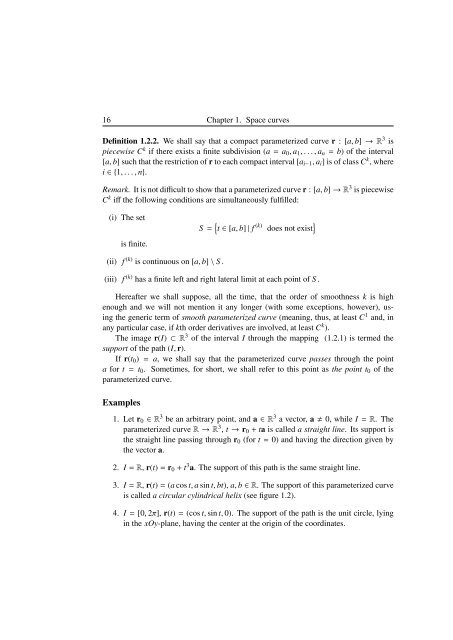Blaga P. Lectures on the differential geometry of - tiera.ru
Blaga P. Lectures on the differential geometry of - tiera.ru
Blaga P. Lectures on the differential geometry of - tiera.ru
You also want an ePaper? Increase the reach of your titles
YUMPU automatically turns print PDFs into web optimized ePapers that Google loves.
16 Chapter 1. Space curves<br />
Definiti<strong>on</strong> 1.2.2. We shall say that a compact parameterized curve r : [a, b] → R 3 is<br />
piecewise C k if <strong>the</strong>re exists a finite subdivisi<strong>on</strong> (a = a0, a1, . . . , an = b) <strong>of</strong> <strong>the</strong> interval<br />
[a, b] such that <strong>the</strong> restricti<strong>on</strong> <strong>of</strong> r to each compact interval [ai−1, ai] is <strong>of</strong> class C k , where<br />
i ∈ {1, . . . , n}.<br />
Remark. It is not difficult to show that a parameterized curve r : [a, b] → R 3 is piecewise<br />
C k iff <strong>the</strong> following c<strong>on</strong>diti<strong>on</strong>s are simultaneously fulfilled:<br />
(i) The set<br />
is finite.<br />
(ii) f (k) is c<strong>on</strong>tinuous <strong>on</strong> [a, b] \ S .<br />
S = � t ∈ [a, b] | f (k) does not exist �<br />
(iii) f (k) has a finite left and right lateral limit at each point <strong>of</strong> S .<br />
Hereafter we shall suppose, all <strong>the</strong> time, that <strong>the</strong> order <strong>of</strong> smoothness k is high<br />
enough and we will not menti<strong>on</strong> it any l<strong>on</strong>ger (with some excepti<strong>on</strong>s, however), using<br />
<strong>the</strong> generic term <strong>of</strong> smooth parameterized curve (meaning, thus, at least C 1 and, in<br />
any particular case, if kth order derivatives are involved, at least C k ).<br />
The image r(I) ⊂ R 3 <strong>of</strong> <strong>the</strong> interval I through <strong>the</strong> mapping (1.2.1) is termed <strong>the</strong><br />
support <strong>of</strong> <strong>the</strong> path (I, r).<br />
If r(t0) = a, we shall say that <strong>the</strong> parameterized curve passes through <strong>the</strong> point<br />
a for t = t0. Sometimes, for short, we shall refer to this point as <strong>the</strong> point t0 <strong>of</strong> <strong>the</strong><br />
parameterized curve.<br />
Examples<br />
1. Let r0 ∈ R 3 be an arbitrary point, and a ∈ R 3 a vector, a � 0, while I = R. The<br />
parameterized curve R → R 3 , t → r0 + ta is called a straight line. Its support is<br />
<strong>the</strong> straight line passing through r0 (for t = 0) and having <strong>the</strong> directi<strong>on</strong> given by<br />
<strong>the</strong> vector a.<br />
2. I = R, r(t) = r0 + t 3 a. The support <strong>of</strong> this path is <strong>the</strong> same straight line.<br />
3. I = R, r(t) = (a cos t, a sin t, bt), a, b ∈ R. The support <strong>of</strong> this parameterized curve<br />
is called a circular cylindrical helix (see figure 1.2).<br />
4. I = [0, 2π], r(t) = (cos t, sin t, 0). The support <strong>of</strong> <strong>the</strong> path is <strong>the</strong> unit circle, lying<br />
in <strong>the</strong> xOy-plane, having <strong>the</strong> center at <strong>the</strong> origin <strong>of</strong> <strong>the</strong> coordinates.












